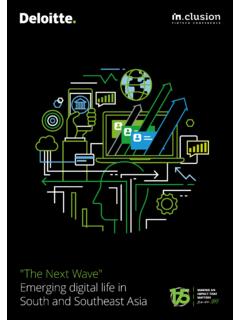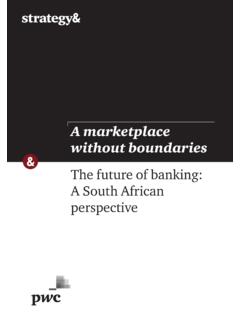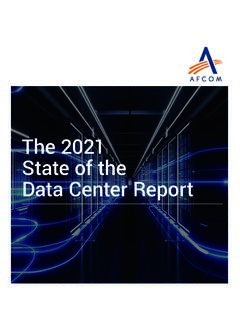Transcription of Digital Transaction Banking Opportunities & Challenges
1 Digital Transaction Banking Opportunities & ChallengesContents1 Foreword 2 An era of digitisation 4 Digital -led change in end-client ecosystem 9 The evolving Transaction Banking landscape 14 Implications for Transaction banks - Case studies 21 Looking forwardImportant Notice from Visa: The contents of this report are provided AS IS and intended for informational purposes only and should not be relied upon for operational, marketing, legal, technical, tax, financial or other advice. You should consult with your legal counsel to determine what laws and regulations may apply to your circumstances. Visa is not responsible for your use of the information contained herein (including errors, omissions, inaccuracy or non-timeliness of any kind) or any assumptions or conclusions you might draw from its use.
2 Important Notice from Deloitte: This report and its contents do not constitute financial or other professional advice, and specific advice should be sought about your specific circumstances. In particular, this report does not constitute a recommendation or endorsement by Deloitte to invest or participate in, exit, or otherwise use any of the markets or companies referred to in it. To the fullest extent possible, Deloitte disclaim any liability arising out of the use (or non-use) of this report and its contents, including any action or decision taken as a result of such use (or non-use). Accordingly, no representation or warranty, express or implied, is given and no responsibility or liability is or will be accepted by or on behalf of Deloitte or by any of its partners, employees or agents or any other person as to the accuracy, completeness or correctness of the information contained in this document or any oral information made available and any such liability is expressly disclaimed.
3 All copyright and other proprietary rights in this report remain the property of Transaction Banking Opportunities & Challenges 1 ForewordDigital adaptation started off as an option but has evolved into a necessity in every bank s agenda around the globe as end-clients consumers, businesses, and governments are quickly adopting trends cascading from the technology sector in their IT capabilities, business operations, and business models. With the digitally-savvy generations coming of age, the manifestations of the rapidly evolving technological changes across all aspects of our lives pose fascinating Challenges and Opportunities alike in the end-clients Digital banks in the region have been largely perceived to be focused on improving existing solutions internally.
4 This internal focus may not suffice in addressing the end-clients demand for Digital functionality and cost-efficiency moving forward. Sensing a quick shift in the client s growing demand for technological capabilities, emerging alternative non-bank players more commonly known as Fintechs are beginning to transform the financial sector by revamping offerings and solutions in the new Digital landscape; some creating sustainable disruption practices while others enabling their clients to do more with less. It is imperative for banks to recognise and act upon fulfilling the growing Digital needs of end-clients in this time of rapid change by seizing the opportunity to establish themselves as early adopters using their incumbent advantage in the financial services is inevitable that banks will need to ramp up investments in their Digital agenda.
5 The Transaction Banking space holds great potential and we anticipate the space to develop at an intense pace and result in an increase in the number of ubiquitously digitised products and offerings. While banks may take comfort in their incumbent advantage, technologically-enabled non-bank challengers have been ramping up their capabilities in a significantly faster pace and are notably stronger today, challenging the privileged access and relationships traditional Transaction banks currently enjoy with their institutional clients. The verdict is clear: banks can either seek to gain the first-mover advantage, or remain on the sidelines and be forced to play catch up this study, we explore in-depth the Digital phenomenon developing in the Transaction Banking landscape by identifying key global technology trends and changes to the end-clients ecosystem, as well as the different degrees of trend prevalence and maturity across key industries.
6 We then examine the current state of the incumbents and alternative service providers in the industry, and finally, we take a glimpse into the road technology continues to advance and consumers demands become more sophisticated, the winners will be those who can keep themselves one step take this opportunity to thank Abhay Chauhan, Ashley Tan, Eric Peffer, Eugene Ho, Hyuna Kim, Ilkka Salminen,Lee Chew Chiat, Muralidhar, Pradipto Goswamee, Stuart Johnston and many others in the firm who supported the development of this report. Mohit MehrotraDeloitte Consulting2An era of digitisationThe rise of Digital nativesWe are now living in an era of digitisation, inhabited by the Digital natives of Generations Y and Z.
7 Generation Y is the first cohort to grow up with the constant presence of computers at home and with access to over 250 cable television channels. On the other hand, Generation Z enjoys high access to technology from birth and is even more accustomed to the lifelong use of communication and media technologies such as the Internet, instant messaging and mobile. As they come of age, these two demographic cohorts are likely to demand ubiquitous access to Digital products and services. With Generation X becoming increasingly digitally-savvy as well, the majority of the population is expected to be technologically-adept by 2025. Spending powerDeloitte estimates the total spending power of end-consumers in Australia, Hong Kong, Malaysia and Singapore to be approximately USD trillion by 2025.
8 Among the consumers, Generations X, Y, and Z will account for 75% of the total spending power. In Malaysia, Generations Y and Z s spending will exceed Generation X s spending; while in Australia, Hong Kong and Singapore, all generations will have a fairly equal distribution of spending power. Australia26%(122)26%(257)25%(408)23%(292 )Hong Kong17%(26)23%(73)30%(162)31%(125)Malays ia30%(82)33%(185)24%(227)12%(88)Singapor e19%(29)28%(88)29%(149)24%(95)6009476032 60 Combined spendingpower of USD trillionFigure 1: Demographic breakdown size and consumer spending by generation, 2025 Total spending by generation, USD billionProportion of each generation(Consumer spending, USD billion)Baby boomers (Born before 1960)Generation X (Born from 1960 to before 1980)Generation Y (Born from 1980 to before 2000)Generation Z (Born after 2000)The implications of increased spending power of the Digital natives will further fuel the growth in end-client Digital demands.
9 In order to capture the next trillion dollar opportunity, businesses and governments are increasingly reorienting facilitation and provision of products/services based on the technological needs of the digitally-savvy generations. Transaction banks needs to be ahead in this race to meet the demands of their Transaction Banking Opportunities & Challenges 3 End-client ecosystemThe end-client ecosystem (Figure 2) illustrates the interactions between Transaction banks, the government and businesses. Within each player in the ecosystem, there are unique segments with differentiated characteristics, preferences and exposure to Digital trends . Figure 2: End-client ecosystemGenerationYGenerationZBusinesse sGovernment-TransactionBanksDigitally-en abledDigitalInsularSmartGovernmentDigita lDinosaure-GovernmentEnd ConsumersProgressivelyDigitalBabyBoomers GenerationXTransaction banks need to understand the varying levels of Digital technology adoption by their end-clients in order to address their needs.
10 Deloitte categorises the three types of end-clients and their Digital adoption levels as follows:Businesses Digital insular: Businesses which have been slow in implementing or adopting Digital solutions Progressively Digital : Businesses which are gradually adopting Digital solutions or are in the process of digitising their products/services Digitally enabled: Businesses with digitised products or services, or building their business models on Digital capabilitiesGovernment Digital dinosaur: Governments with department or functions working in siloes due to highly manual processes e-Government: In transition towards Digital processes and going paperless, with increased cross-functional flow of data or information Smart government: Seamless integration of functions and flow of information, enabling execution of citizen-centric policies and processesEnd consumers Baby boomers: Born before 1960 Generation X: Born from 1960 to before 1980 Generation Y: Born from 1980 to before 2000 Generation Z.













